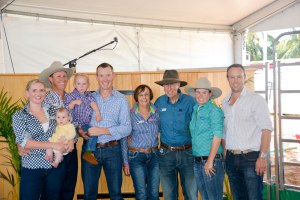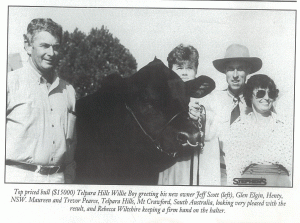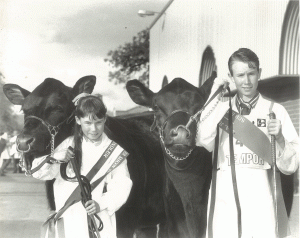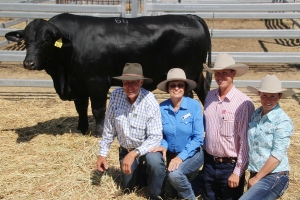Looking Forward, Looking Back: Trevor Pearce
Looking Back
Looking back over the past 50 years my desire to breed livestock may have been inherited from my forebears who bred and showed top Merino sheep in the mid north of South Australia after WWII.
Here I was introduced to the visual evaluation and selection of top quality animals and it led to endless opportunities for my father, brother and me as this journey unfolded.

The name TELPARA was first developed in the 1950s with black Australorp chickens. The first initial of all our names Trevor, Edwin Lovell (second name) Philip were used and blended into the Para shire where we lived.
Incredibly Telpara Australorps won three South Australian Department of Agriculture egg laying competitions consecutively from 1956-58 and I guess this was our first taste of successful stud breeding.
It was also my early start in performance recording and developed my philosophy of identifying the best individuals and breeding from them. At this time a world renowned Dutch geneticist Dr. A L Hagedoorn published research papers which aroused my enthusiasm for pedigree performance breeding and progeny testing of livestock species. His research still has some clear relevance for breeders today.
In 1964 we first registered our meat breed sheep stud as Telpara Hills and soon found ourselves in the midst of the fiercely competitive show scene at Adelaide Royal Show, when showing was used as the prime form of stud promotion. Wealthy owners employed full time studmasters/grooms who were both artist and a craftsman combined and jealousy guarded their secrets of stockmanship.
Objective measurement was unheard of at this time. Imported animals, particularly from the UK, together with show champions were considered the elite of genetics and the levels of feeding, preparation and showmanship were extreme. Nevertheless we enjoyed much success, culminating with one of our Hampshire Down rams being named Champion of Champions under a 17 judge panel scheme in the 1980s.
At this time we were breeding Murray Greys but I always had a yearning for Black Angus, maybe because of my mother’s Scottish heritage.
Over the 1980s we built a select Angus stud, even bought a pregnant recipient with a Canadian embryo inside, and steadily promoted our stud through showing, field days, and sales. Even in these early days, we started getting on EBV trait leader lists with our cattle.

Our entire family of 4 children were involved in the family stock showing from very early in their lives. Great memories are held by them all of their adventures as ‘show shed kids’ as they learned to successfully prepare, show and judge cattle. Many of their misdemeanours have only just been revealed to Maureen and I much later in life. How Maureen coped with parenting, babies, and food preparation was a miracle indeed. She still does an amazing job coping with our wonderful stream of visitors to the stud.
Stephen actually won a major Angus Society judging competition at age 14. He was too young to accept the prize of 3 months scholarship to USA!
In 1992 our lead bull topped the then prestigious Wodonga Angus National Show and Sale and was the highest priced Angus bull sold in Australia for the year!

Even at this time we were favouring bigger cattle and we had the distinction of being the first stud to break the 1000 kg barrier for Angus bulls under 2 years at the National Sale.
Back in South Australia we were struggling with poor seasons, soil, water salinity, flies and snakes at our farm in Keith and we moved out of our comfort zone to relocate to the iconic Far North Queensland in 1995.
This has proven highly successful but not without some hard knocks early and certainly has now opened up endless opportunities for us. Seeing how our Angus semen influenced females we purchased stud Australian Brangus cattle from the ABCA sale in Rockhampton and 60 stud females from a leading Brangus breeder.
Very quickly we realised that we needed to stabilise our breeding programme. As the fates would have it , Stephen at that point won a scholarship to Texas A&M University where he met his wife Brittany, and saw purebred 3/8 multigenerational Brangus at one of the largest seed stock producer’s ranch Camp Cooley, home of the Brinks herd. This suddenly re-injected our interest in the breed’s potential in AU . Now by importing elite embryos from our carefully selected donor herd we assembled in Texas our family reached a position where we have a world class high quality herd in AU.
This new type of Brangus has inspired many new and old cattlemen like me about the potential greatness of Brangus. Many have seen the Telpara Hills type of cattle as a golden opportunity to value-add to their herds and make their operations profitable.
Sales within the breed by Telpara Hills and our clients suddenly set new records hitherto unheard of in the breed. The former sleeping giant Brangus jumped into commercial focus as these purebred Brangus proved they could breed like their figures and their looks.
At Telpara Hills though we have not taken our success for granted and we know we have an obligation to further continue this breed thrust.
Looking Forward
Our latest challenge is to guard against an overseas trend towards the breeding of moderate cattle. I believe this move is counterproductive for us as we need bigger cattle capable of walking large distances and delivering increased weight for age in their progeny.
Over the years also in all stock breeding I have found emphasis upon low birth weight sires usually by studs seeking to calve heifers at two years of age is fraught with problems. These small calves rarely match their average birthweight siblings at weaning. I like to see heifers calving at 2 ¼ years of age when they are more developed and ready for the demands of production. Then another issue arises as to what bulls to use over these small born heifers. Very quickly lack of size (and weight for age) becomes driven into your herd.
When asked what I see in the future for the stud industry my thoughts are as follows:
1. The show scene will survive; albeit in a limited way as particularly newer studs use it as a promotional and social tool
2. EBVs will expand hugely and drive commercial cattleman’s selections
3. Multi-breed EBVs will be developed with greater accuracies
4. Parent verification (using DNA) will become mandatory for stud stock registration
5. Natural polledness will be demanded by buyers
6. Premiums for branded products will become widespread
7. Carcase quality genomics will allow beef producers to select for eating qualities and allow beef to further challenge the white meat group
It has been rewarding to be able to look back and see the progress and development made within the stud stock industry and what our family has achieved working together.
There’s no way I could have been a successful part of this scene without an amazing supportive and tolerant wife. Maureen has been with me for more than 50 years and has made this journey as a family possible. She is the gel who keeps the parts sticking together on a wide variety of fronts and is a great decision maker. Now our four children Greg, Anthony, Stephen and Fiona are all continuing to play their individual parts and maintain my passion to breed world class cattle. Stephen’s wife Brittany has taken the marketing of our business to a world class level.
Our younger children Stephen and Fiona along with Brittany are now the face of the stud both domestically and overseas and are taking the business to heights I certainly could never have envisaged when I started those 50 plus years ago.

